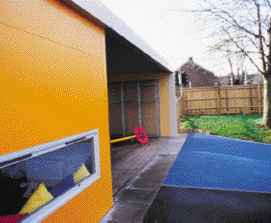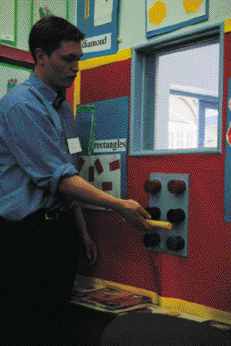|
2B.1
Lighting
2B.2 Acoustics
2B.3 Heating, ventilation and water
2B.4 Finishes, fixtures and landscape
2B.5 Furniture
Positive places
The following links have been suggested by studies into the
relationship between the environment and learning, particularly
in relation to pupils with special educational needs or disabilities.
•
When asked what they like about an environment, most children
mention colour, light and space.
• Natural light, or wide-spectrum high frequency
fluorescent lighting is preferable to low frequency (50Hz)
fluorescent lighting.
• The use of yellow, beige or off-white surface
colours can stimulate learning while light blue, green and
lavender can be calming, but some vibrant colours can over-excite
and have a negative effect on learning.
• Certain scents can aid problem solving, for
example peppermint, basil and lemon can stimulate thinking
while lavender, camomile and rose can relax and calm. These
findings, however, cannot be universally applied as individuals
react differently to their environment. For example, some
learners find concentration, understanding and recall enhanced
by background music, while others require total silence. For
more information see Building Bulletin 94
|
|
PHYSICAL
PROVISION FOR PUPILS WITH EMOTIONAL AND BEHAVIOURAL
DIFFICULTIES
All pupils need to have schools and classrooms that
are attractive, with good lighting, heating and acoustics.
Research shows that warm, bright, stimulating and well
cared for classrooms can send pupils powerful messages
about the importance a teacher places on the achievement
of learning and the nature of the relationship they
wish to build. Comfort, respect and stability in the
classroom are vital educational building blocks.
Pupils with emotional and behavioural difficulties (EBD)
are particularly reactive to the physical environment
and are less tolerant when the context is not conducive
to learning. They also have lower concentration spans.
Other factors may also be influential. It has been suggested
that certain music can affect pupils, particularly if
it is gentle and quiet. Colour can positively affect
mood and behaviour. On the negative side, poor sound
insulation between classrooms and other learning spaces
can lead to pupil distractions.
Taken from John Visser, Aspects of physical provision
for pupils with EBD. Support for Learning (2001 vol
16.2)
|
|

 GROVE ROAD PRIMARY, Hounslow
GROVE ROAD PRIMARY, Hounslow